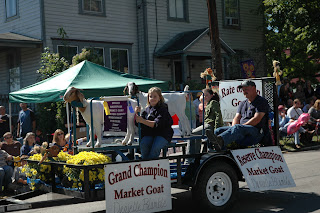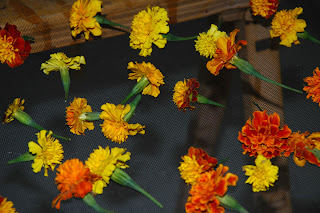HIDE……..
and PEEK!
After three long days of hard work, we finally have everyone situated. We decided to use Goliath before we sell him and take advantage of his ‘Wild and Wooly’ Coopworth bloodlines.
Some great matches for Hercules will produce more lambs with his wonderful Wensleydale fleece characteristics.
What can you say about Poseidon… beautiful fleece, fast growing lambs, and hopefully fewer ram lambs this season.
Zeus (he of great condition, wonderful fleece and very, very few worms) also has a small breeding group of ewes, but he is so nosy that we haven’t been able to get a good picture yet.
Pictured below is Liam’s group of registered Border Leicester ewes and BL crosses. We are really anxious to see the lambs produced by some of the yearling ewes (our first lambs).
And so… with the ceremonial ‘turning in of the rams’… let the breeding begin!
We devoted today to dyeing. Early this morning we began by mordanting a pound of yarn for future projects. We simmered the yarn for an hour in an alum mixture, and when dry it will be ready for more dyeing with the plant material we have drying from our dyer’s garden.
Next, we moved on to our big task of the day, dyeing with Japanese Indigo or Dyer’s Knotweed.
Using fresh leaves from our garden, we heated them in a huge make-shift double-boiler until the water reached 160 degrees. We then strained the leaves and added baking soda to the fluid to make it alkaline. Pouring the liquid back and forth from one container to another allowed the indoxyl to react with the oxygen in the air and change into indigo.
We then added a reducing agent to convert the indigo into a yellowish form to prepare it for dyeing. We added wet yarn and soaked it for 30 minutes.
We gently lifted the yarn out of the dyebath.
And, ‘like a miracle’ the yarn turned from yellow to blue as it reacted with the oxygen in the air.
Pretty exciting stuff! We also boiled the leaves left over from the indigo production and dyed 4 ozs of mordanted yarn. It turned out very pretty, kind of a gold-khaki color. Will post pictures of it later.
We decided to shear the lambs a couple weeks earlier than last year with the hope that we will have longer spring fleeces from the keepers. Joe Viola, from Horse Shoe Run, did another super job shearing.
We are so pleased with the condition that the lambs are in. It is a little easier to score them with those heavy fleeces off. Shown below are twins, 712 and 713, both in great condition and for sale.
We are really pleased with this beautiful crop of fall lamb fleeces. Now on to the big job of skirting and processing. Look for raw fleece, washed and picked fleece, roving and other products on our two storefronts, eBay and Etsy links from our web-site.
It’s Farmer’s Day at the Buckwheat Festival and after the Ag-Olympics and other morning activities, it is finally time for the Farmer’s Day Parade (our favorite of the three).
Royalty comes first, of course. Here is King Buckwheat, Jonathan Mauldin, of Aurora, joined by his train bearers and the Little Princesses.

Lena’s 4-H club, the Aurora Pioneers, won the Lamb Dressing Contest with their ‘Grease’ themed entry.
Show day at the Preston County Buckwheat Festival has finally arrived! Everyone pitches in to help. Lena gives a pre-show pep talk.
Goliath is ready!
The boys and girls are waiting their turn in the show ring.
Show ring wisdom provided by the judge.
Many thanks to judge, Gabriel Shane Zepp, (from Carroll County, Maryland) who managed to remain professional and enthusiastic despite enduring a 12 hour day judging 139 market swine and then feeder calves and crossbred heifers before even beginning the Purebred Sheep Show.
Judging for Supreme Grand Champion Wool Ewe, lambs Cassidy and Hannah, and yearling ewe, Princess, are participating.
All summer long we have been picking the marigold blossoms from our dye garden and drying them. We devoted today to dyeing.
We boiled the flowers, prepared the dyepot and soaked the roving.
Here is the result on some blue-faced leicester mordanted roving. The color is actually deeper and much richer than the picture shows. It really turned out quite lovely.
When we went to feed this evening, we were surprised to find two little guinea eggs in the coop!
They are very small as you can see when they are placed in a regular egg carton. (To incubate or not to incubate that is the question.)
The guineas have developed into lovely birds with these beautiful facial features which are kind of fluorescent in the twilight.
There is now no hesitation when the coop is opened in the morning. They hop right out and rush into the barn to their feed pan.
At the slightest sound at least one of them pops their head up to see if it is necessary to sound the alarm.
Once they are assured that everything is right with the world, off they go to explore.